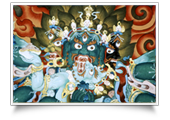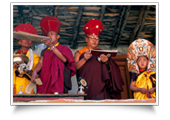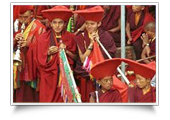|
|
|
|
 |
 |
|
Cultural Tours in Ladakh |
 |
|
|
 Ladakhi culture is heavily influenced by Tibetan culture, in fact it is quite similar. There are more Buddhists than Muslims in certain areas and the ratio changes as we move towards Zanskar valley. Ladakhi food has much in common with Tibetan food, the most prominent foods being thukpa (noodle soup) and tsampa, known in Ladakhi as ngampe (roasted barley flour). Ladakhi culture is heavily influenced by Tibetan culture, in fact it is quite similar. There are more Buddhists than Muslims in certain areas and the ratio changes as we move towards Zanskar valley. Ladakhi food has much in common with Tibetan food, the most prominent foods being thukpa (noodle soup) and tsampa, known in Ladakhi as ngampe (roasted barley flour).
A dish that is strictly Ladakhi is skyu, a heavy pasta dish with root vegetables. As currency started making its place in the economy of Ladakh, food from the Indian plains gained popularity. Tea in Ladakh is traditionally made with strong green tea, butter, and salt. It is mixed in a large churn and known as gurgur cha(Butter Tea), after the sound it makes when mixed. The milk and sugar based sweet tea made in Indian style is also common now. Most of the surplus barley that is produced is fermented into chang, an alcoholic beverage drunk especially on festive occasions.
 Ladakhis are very fond of ice hockey which is generally played in the month of January on natural ice. Archery is a traditional sport and many villages still conduct archery festivals, which also include drinking, dancing and gambling as a medium of celebrating the sport. Polo is another traditional sport of Ladakh. Ladakhis are very fond of ice hockey which is generally played in the month of January on natural ice. Archery is a traditional sport and many villages still conduct archery festivals, which also include drinking, dancing and gambling as a medium of celebrating the sport. Polo is another traditional sport of Ladakh.
The architecture in Ladakh draw heavy influences from Tibet and India. The monastic architecture reflects a deeply rooted Buddhist approach. The Buddhist wheel, along with two dragons, is a common feature on almost every gimp, including the likes of Hemis, Thiksey, Alchi etc. Ladakhi Buddhist festival music is much like its Tibetian counterpart and often involves religious chanting. These chants are complex, often recitations of sacred texts in celebration of various festivals. |
|
| HEMIS FESTIVAL |
 Hemis festival is one of the most famous monastic festivals in June to commemorate birth of Guru Padmasambhava, the founder of Tantric Buddhism in Tibet. The sacred dance drama of the life and mission is performed wearing facial masks and colorful brocades robes. The three-day festival takes place from 9th to 11th. Especially the monkey year festival, which comes in a cycle of 12 years. During it the four-storey thanka of Guru Padma Sambhava is hung in the courtyard and other precious thankas are also exhibited. Hemis festival is one of the most famous monastic festivals in June to commemorate birth of Guru Padmasambhava, the founder of Tantric Buddhism in Tibet. The sacred dance drama of the life and mission is performed wearing facial masks and colorful brocades robes. The three-day festival takes place from 9th to 11th. Especially the monkey year festival, which comes in a cycle of 12 years. During it the four-storey thanka of Guru Padma Sambhava is hung in the courtyard and other precious thankas are also exhibited.
|
|
| THIKSEY, KARSHA AND SPITUK GUSTOR |
 Gustors take place at Thiksey, Spituk and Karsha in different months of the year. The festival takes place for two days. The celebration is to mark the victory over evils. The mask worn by the dancers represent the Guardians, Protectors and the Gods and Goddesses. The festival ends with the symbolic assassination of evils and burning of the effigy of evils. Gustors take place at Thiksey, Spituk and Karsha in different months of the year. The festival takes place for two days. The celebration is to mark the victory over evils. The mask worn by the dancers represent the Guardians, Protectors and the Gods and Goddesses. The festival ends with the symbolic assassination of evils and burning of the effigy of evils. |
| DOSMOCHEY |
 Dosmochey is celebrated in Leh (Leh Palace), Liker (Lower Ladakh) and Deskit (Nubra valley) monasteries in February. The most famous among all is Leh Dosmochey, which is celebrated for two days in the courtyards of the Leh palace. The monks from different monasteries perform the Chams every year turn by turn. The festival takes place in the end and starting of the Tibetan New Year. The monks of Takthok monastery prepares the offering with Thread crosses which binds all the evil, hungry ghosts and guard against natural disaster in the coming year. On the second day of the festival, the offerings are taken out of the town in a procession and burn it while people whistle to chase away the evil spirits. Dosmochey is celebrated in Leh (Leh Palace), Liker (Lower Ladakh) and Deskit (Nubra valley) monasteries in February. The most famous among all is Leh Dosmochey, which is celebrated for two days in the courtyards of the Leh palace. The monks from different monasteries perform the Chams every year turn by turn. The festival takes place in the end and starting of the Tibetan New Year. The monks of Takthok monastery prepares the offering with Thread crosses which binds all the evil, hungry ghosts and guard against natural disaster in the coming year. On the second day of the festival, the offerings are taken out of the town in a procession and burn it while people whistle to chase away the evil spirits. |
| MATHO NARANG |
 Matho Nagrang is celebrated on the 15th day of the 1st month of Tibetan calander, at Matho monastery, the only monastery of the Sakya School of Tibetan Buddhism. During these two days of festival mask dances are performed by monks of the monastery wearing colorful silk brocaded robes and mask in different forms of God and Goddesses. The festival is famous because of appearance of the two oracles during the festival after full month meditation in complete isolation. The two oracles appear in the courtyard accompanying mask dancers and predict future events and people from far and away come to seek advice to perform ritual to tackle with disasters. Matho Nagrang is celebrated on the 15th day of the 1st month of Tibetan calander, at Matho monastery, the only monastery of the Sakya School of Tibetan Buddhism. During these two days of festival mask dances are performed by monks of the monastery wearing colorful silk brocaded robes and mask in different forms of God and Goddesses. The festival is famous because of appearance of the two oracles during the festival after full month meditation in complete isolation. The two oracles appear in the courtyard accompanying mask dancers and predict future events and people from far and away come to seek advice to perform ritual to tackle with disasters.
|
| STOK GURU TSECHU |
 The monks of Stok and Spituk monasteries also celebrate Stok Gruru Tsechu for two days with mask dances performed. It is also held in Feb. around a week before the Matho Nagrang. During the festival two oracle appears, but they are laymen from the same village prepared
by monks to receive the spirit of the deities. The monks of Stok and Spituk monasteries also celebrate Stok Gruru Tsechu for two days with mask dances performed. It is also held in Feb. around a week before the Matho Nagrang. During the festival two oracle appears, but they are laymen from the same village prepared
by monks to receive the spirit of the deities. |
| PHYANG TSEDUP |
 Phyang Tsedup takes place in July / August. Like other monasteries, monks wearing colorful brocade robes and Mask in the form of different god and goddesses perform mask dances. The huge thanka of Skyoba Giksten Gonbo is hung in the courtyard during the festival. Phyang Tsedup takes place in July / August. Like other monasteries, monks wearing colorful brocade robes and Mask in the form of different god and goddesses perform mask dances. The huge thanka of Skyoba Giksten Gonbo is hung in the courtyard during the festival. |
| YURU KABGYAT |
 The 2-day festival takes place in July in Lamayuru monastery around 125 kms. from Leh. Monks like other monastic festival perform mask dances. During the festival monks perform prayer and rituals to get rid of disaster and peace in the world.
The 2-day festival takes place in July in Lamayuru monastery around 125 kms. from Leh. Monks like other monastic festival perform mask dances. During the festival monks perform prayer and rituals to get rid of disaster and peace in the world. |
| LOSAR CELEBRATION |
 The Losar (New Year) celebration is followed by Galdan Namchot, the birth anniversary of Tsogkha pa who introduced Gelukpa School of order. During Namchot people illuminate their houses, monasteries and mountains and make offerings in the houses and monasteries.
The Losar (New Year) celebration is followed by Galdan Namchot, the birth anniversary of Tsogkha pa who introduced Gelukpa School of order. During Namchot people illuminate their houses, monasteries and mountains and make offerings in the houses and monasteries.
The Losar festival is celebrated in the eleventh month of Tibetan calendar, two months ahead of Tibetan New Year. In early 17th century, King Jamyang Namgyal decided to lead an expedition against the Baltistan forces in winter; therefore he decided to celebrate the festival two months before. Later it became a tradition and being celebrated in the eleventh month.
The festival lasts for around a month, during which Gods, deities, ancestors and even the animals are fed without fail. Images of Ibex are made as auspicious symbol, walls of the kitchens are dotted and are believed to bring prosperity in coming year. The Metho (procession of fire) is thrown out chanting slogans and chasing hungry ghosts and evil spirits, and they return with rocks of ice as auspicious symbol and these are kept in the store. In some villages there is a tradition of making Old men and women, from this snow which last for a week. Over all the Losar all children and young and olds enjoy and celebrate the festival. All family members get together to celebrate if someone missing will have their cups filled with tea by their name. |
| LADAKH FESTIVAL |
 Ladakh festival takes place in September 1-15 every year in Leh and villages. The inauguration ceremony takes place in Leh on large scale with the procession of various cultural troupes from different part of Ladakh.
Ladakh festival takes place in September 1-15 every year in Leh and villages. The inauguration ceremony takes place in Leh on large scale with the procession of various cultural troupes from different part of Ladakh.
It passes through Leh Market dancing, singing with traditional music, in colorful traditional Ladakhi dresses, and finishes at Polo ground after performing their best dances and songs. The festival last for 15 days with regular program in different villages. The program includes Archery, Polo, and Mask Dances from the monasteries, traditional dances by cultural troupes from Villages. There are series of musical concert and dance program in Leh town. |
|
| Sindhu Darshan (Visit Indus) Festival |
 Sindhu Darshan is three-day festival held from 1st to 3rd June, in Shey Manla around 8 kms. from Leh on the bank of Indus river. For the first time it was organized in October 1997, as a symbol of unity and Communal harmony and national integration. Whilst promoting domestic tourism in Ladakh. It is also a symbolic salute to brave soldiers of India who have been fighting not only with enemies in the in the human form but also in the form of nature.
Sindhu Darshan is three-day festival held from 1st to 3rd June, in Shey Manla around 8 kms. from Leh on the bank of Indus river. For the first time it was organized in October 1997, as a symbol of unity and Communal harmony and national integration. Whilst promoting domestic tourism in Ladakh. It is also a symbolic salute to brave soldiers of India who have been fighting not only with enemies in the in the human form but also in the form of nature.
During this festival artists from different parts of the country perform traditional dances and people from all religions, castes and regions participate. |
|
|
|
|
|
|
|
